Reserve Bank of Australia Annual Report – 2007 Operations in Financial Markets
The primary reason the Reserve Bank operates in financial markets is to implement its monetary policy decisions. However, the Bank also undertakes a large volume of transactions on behalf of clients, particularly in the foreign exchange market, and transacts on its own account to manage its balance sheet.
In recent years, there has been a substantial increase in the size of the Reserve Bank's balance sheet, reflecting the increase in deposits placed with the Bank by the Australian Government and its agencies, in particular the Future Fund. Over the past five years, the balance sheet has risen by 120 per cent to $132 billion. This growth, combined with the decline in Commonwealth Government securities (CGS) on issue, has had a significant impact on the Bank's operations. To offset the effect of these and other flows on domestic liquidity, the Bank has accepted a broader range of domestic securities and made greater use of its foreign portfolio, initially through foreign exchange swaps.
| June 2002 |
June 2006 |
June 2007 |
|
|---|---|---|---|
| Assets | 60 | 105 | 132 |
| Foreign | 37 | 74 | 96 |
| – Net reserves(a) | 7 | 30 | 32 |
| – FX swaps | 29 | 34 | 48 |
| – Other | 1 | 10 | 16 |
| Domestic | 23 | 31 | 36 |
| Liabilities | 60 | 105 | 132 |
| Deposits | 14 | 43 | 66 |
| Currency | 32 | 38 | 40 |
| Other (including capital) | 14 | 24 | 26 |
| (a) Excludes Special Drawing Rights and Australia's reserve position at the International Monetary Fund | |||
In 2006/07, the Reserve Bank's net purchases of assets from the market were around $27 billion. This comprised an increase of $22 billion in holdings of foreign assets, mostly purchased under foreign currency swap arrangements, and around $5 billion of domestic assets. Most of the increase in domestic assets was securities issued by State and Territory government borrowing authorities (semis) bought under repurchase agreements (repos). At the end of June 2007, semis accounted for around 31 per cent of the Bank's portfolio of domestic securities, up from 25 per cent a year earlier. The share of the domestic portfolio in commercial bank paper bought under repo was around 43 per cent, a little lower than a year earlier.
This rate of expansion of the balance sheet, however, is unlikely to continue in the period ahead. The Future Fund has begun to run down its deposits at the Reserve Bank and invest the proceeds in a broader range of assets. These withdrawals have been fairly small to date but the process is expected to continue throughout 2007/08, leading to some contraction of the Bank's balance sheet over the year.
The effectiveness of the Reserve Bank's operations in financial markets has not been affected by the growth of the balance sheet. Furthermore, the increased size of the Bank's asset holdings has not been reflected proportionately in the Bank's risk exposure, namely its exposure to changes in interest rates and exchange rates. This is because the Bank has structured its operations to minimise the increase in risk, largely by investing in short-term assets with little foreign exchange exposure. Overall, the Bank's risk exposure remains adequately covered by its capital.
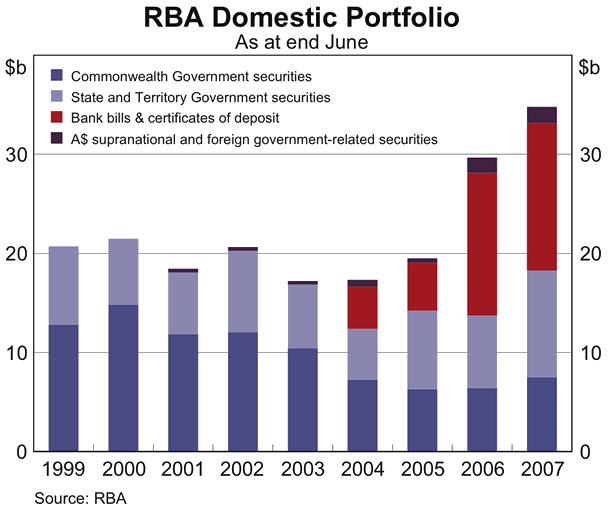
Domestic Market Operations
Monetary Policy Implementation
Monetary policy is determined by the Reserve Bank Board and is effected in terms of an operational target for the cash rate – the interest rate on unsecured overnight loans between banks in the money market. This rate is a key determinant of interest rates in other wholesale and retail markets, which in turn affect economic activity and inflation.
The Board increased the target for the cash rate on two occasions in 2006/07 – from 5.75 per cent to 6.0 per cent at its August 2006 meeting and then to 6.25 per cent at the November meeting. The target was increased further in August 2007, to 6.5 per cent. These actions were part of a gradual tightening of monetary policy in Australia that began in 2002. The rationale for the changes was provided at the time through media releases and subsequently in the Reserve Bank's quarterly Statement on Monetary Policy and appearances by the Governor and senior officers before the House of Representatives Standing Committee on Economics, Finance and Public Administration.
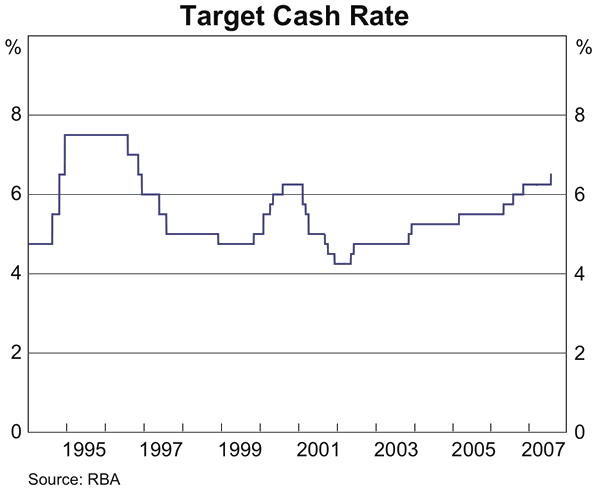
Once the Board's decision on the target for the cash rate is announced, the operational responsibility of Domestic Markets Department is to ensure that the cash rate in the market remains close to the target. The announcement of a change is normally sufficient in itself to move the cash rate to the new target, though, over time, the Bank needs to undertake transactions to ensure that it stays around this level. These transactions – which are also referred to as open market operations – are aimed at affecting the aggregate level of balances held by banks in accounts with the Reserve Bank. These balances, known as exchange settlement (ES) balances or ES funds, are the most immediate source of liquidity available to the banks to meet their daily settlement obligations to each other and to the Reserve Bank.
The Reserve Bank manages changes in the aggregate supply of and demand for ES funds – which would otherwise produce significant variations in the cash rate from the target – by buying and selling securities, usually under repos. The Bank liaises closely with its banking customers – the most significant being the Australian Government – and with commercial banks to identify potential changes in the supply of and demand for ES funds. On the basis of this information, it adjusts the size of its daily market operations to keep the cash rate close to the target. While the demand for ES balances by individual banks can vary from day to day, banks in total have sought to hold around $750 million in daily balances over recent years.
The arrangements for managing the supply of ES funds have proved to be effective and are well understood by participants in the wholesale money market. As in recent years, there were few occasions in 2006/07 on which the actual cash rate deviated from the target; the vast majority of transactions in the market for overnight funds took place at the target rate. Notwithstanding the stability of the cash rate, activity in the overnight cash market has continued to rise. Average daily turnover in 2006/07 was around $7 billion, some 60 per cent higher than in the previous year.
The Reserve Bank's operations in the domestic market are conducted each morning, though on rare occasions a second round of operations may be undertaken later in the day to offset large unexpected flows or shifts in demand for ES funds. No second-round operations were conducted in 2006/07.
| Number of times used |
Value ($ million) | |
|---|---|---|
| 2001/02 | 11 | 673 |
| 2002/03 | 14 | 1,673 |
| 2003/04 | 24 | 2,159 |
| 2004/05 | 11 | 1,394 |
| 2005/06 | 10 | 436 |
| 2006/07 | 24 | 3,589 |
The Reserve Bank also offers a standing facility under which banks can borrow funds overnight on a secured basis, but at a 25 basis point margin above the cash rate. Banks will typically use this facility late in the day if they face operational or other factors that limit their ability to source funds in the market. The facility was used on 24 occasions in 2006/07 for a total value of $3.6 billion. While this was more than in recent years, it did not reflect any particular development in the market.
Turnover of domestic securities in market operations by the Reserve Bank was $464 billion in 2006/07, $45 billion more than in 2005/06. As in previous years, the vast majority of these operations were repos, which offer greater flexibility in managing liquidity than outright transactions because their maturities can be tailored to accommodate anticipated changes in liquidity. The average maturity of repos, at 17 days, was around the same as in the previous financial year. An increase in the size of ES flows from day to day largely accounted for the increase in turnover in market operations.
| 2002/03 | 2003/04 | 2004/05 | 2005/06 | 2006/07 | |
|---|---|---|---|---|---|
| Repurchase agreements(a) | |||||
| – Purchases | 304 | 272 | 391 | 409 | 459 |
| – Sales | 17 | 11 | 10 | 6 | 2 |
| Outright purchases(b) | 3 | 5 | 5 | 4 | 3 |
| Total operations in domestic securities | 324 | 287 | 405 | 419 | 464 |
| Foreign exchange swaps(a) | 90 | 139 | 106 | 157 | 211 |
| Total | 414 | 426 | 511 | 576 | 675 |
|
(a) First leg of transaction. (b) CGS only until 2002/03. Thereafter includes State and Territory Government securities. |
|||||
As has been the case for a number of years, foreign exchange swaps played a significant role in the Reserve Bank's market operations during 2006/07. For example, if the domestic banking system is short of funds, the Bank will undertake a swap in which it lends Australian dollars to the market in exchange for foreign currency for a specific period and at an agreed exchange rate for the reversal of the transaction.[1] This transaction has the same effect on domestic liquidity as using open market operations to buy government securities under repo. The difference between the two is that Australian dollars are exchanged for foreign currency in a swap, whereas they are exchanged for a domestic security in a repo. The bulk of the swaps has generally been for relatively short maturities, around two to three months, which aligns with the maturity of the Bank's deposit liabilities. Reflecting the greater usage of foreign exchange swaps for liquidity purposes, turnover in those instruments rose from $157 billion in 2005/06 to $211 billion in 2006/07.
Long-dated Liquidity Operations
In addition to the market operations noted above, the Reserve Bank also buys longer-dated securities on an outright basis in the secondary market. The purpose of these operations is to provide some maturity diversification in the Bank's portfolio of domestic assets.
When long-dated operations were introduced in late 2004, the Bank indicated that it would generally look to make purchases of around $50 to $100 million at fairly regular intervals. The Bank also indicated in its consultations with market participants that, while there was no firm target, acquiring around $2 billion of State and Territory Government securities over time would be likely to satisfy the Bank's portfolio objectives as well as provide sufficient securities to undertake market operations if needed. In 2005 and the first part of 2006, the Bank conducted long-dated operations roughly once a month. During 2006/07, it undertook six longdated operations, purchasing a total of around $600 million of securities, which brought the value of longer-dated semis in the domestic portfolio to $2.0 billion.
Securities Lending
The Reserve Bank lends securities that it holds on an outright basis on its balance sheet. These transactions assist the flow of securities through the market and allow market participants to meet settlement obligations. Most of the Bank's transactions involve lending CGS, though a small share of lending from the Bank's portfolio also involves semis. The Bank's income from securities lending rose by $0.25 million to $1.14 million in 2006/07, largely due to a rise in the average maturity of lending transactions from around six to nine days.
| Number of transactions |
Amount lent (face value, $ billion) |
Net income ($ million) |
|
|---|---|---|---|
| 2001/02 | 119 | 3.1 | 0.27 |
| 2002/03 | 32 | 0.9 | 0.13 |
| 2003/04 | 185 | 5.0 | 0.50 |
| 2004/05 | 264 | 11.9 | 0.56 |
| 2005/06 | 460 | 20.3 | 0.89 |
| 2006/07 | 438 | 22.4 | 1.14 |
In addition to lending securities from its own portfolio, the Reserve Bank operates a securities lending facility on behalf of the Australian Office of Financial Management (AOFM). This facility allows market participants to access any line of Treasury bonds but at a penalty relative to market prices for securities lending. Securities lending transactions through the AOFM facility are typically small in number and volume, reflecting the penalty in the price. Total lending through the facility was $1.3 billion in 2006/07, slightly more than the previous year.
Foreign Exchange Operations
The Reserve Bank's operations in foreign exchange markets in 2006/07 comprised two main activities. The first was transactions in the foreign exchange market on behalf of its clients. The largest client is the Australian Government, which has an ongoing need for foreign currency to cover items such as defence expenditure, embassy running costs and foreign aid. Over the course of the year, these foreign currency needs totalled $5.1 billion, about $400 million higher than the previous year. The Bank covered these sales by buying foreign currency in the market. Consequently, these sales had no impact on the Bank's overall holdings of foreign currency. This is the normal course of business unless the Australian dollar is judged to be at exceptionally low levels, in which case the Bank may choose to meet the Government's foreign currency requirements out of its net reserves.
Secondly, as described above, the Reserve Bank has made increasing use of foreign exchange swaps to manage domestic liquidity, as the size of the balance sheet has grown with the increased level of deposits lodged at the Bank and as the amount of CGS outstanding has declined.
During 2006/07, the Bank did not undertake any transactions to influence the overall level of the exchange rate. Transactions of this nature, known as intervention, are usually undertaken when the exchange rate has moved a long way from its long-term average and in a way that is inconsistent with economic conditions. While the Australian dollar appreciated to an 18-year high against the US dollar and a 22-year high on the tradeweighted index, the Bank viewed these movements as being broadly consistent with developments in the Australian economy, particularly the continued increase in Australia's terms of trade to its highest level in over five decades.
More generally, the Bank has not sought to influence the exchange rate following the period between 1997 and 2001 when it sold foreign currency to support the Australian dollar. Since then, a process of rebuilding reserves has been undertaken, in which the Bank has utilised periods of exchange rate strength to add to reserves in a measured way. With the exchange rate appreciating to multi-year highs during 2006/07, the Bank took the opportunity to step up the pace of its reserves building operations from that undertaken in 2004/05 and 2005/06. Most of these purchases took place between March and June 2007, when the exchange rate reached its highs. Additions to reserves, including earnings, over 2006/07 were $4.9 billion, around twice that accumulated in 2005/06. However, the effect of these purchases on the Australian dollar measure of foreign exchange reserves was partially offset by valuation losses generated by the appreciation of the Australian dollar against those currencies in which reserves are held. Consequently, net foreign reserves (i.e. official reserve assets excluding those held under foreign currency swaps) increased to $32.2 billion at the end of June 2007 from $30.2 billion a year earlier. Gross reserve assets, which also include foreign exchange held under swaps, increased from $64 billion in 2005/06 to $80 billion, primarily reflecting the increase in swaps over the year noted previously.
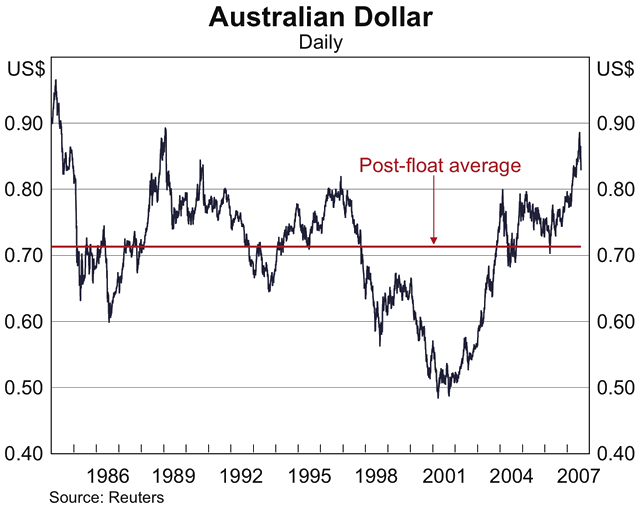
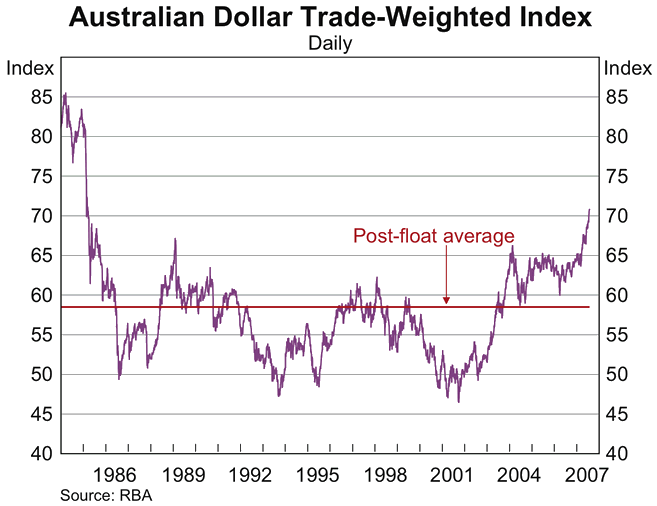
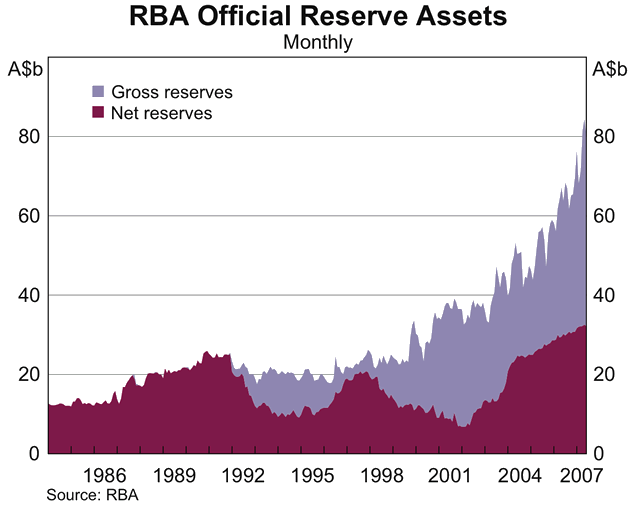
Reserves Management
The Reserve Bank holds a portfolio of foreign currency denominated assets and gold, which form the major part of Australia's official reserve assets.[2] The Bank's primary concern in managing these assets is their security and liquidity. By focusing on these factors, the Bank aims to ensure that these assets are both secure and available for use at short notice to fund intervention. Subject to these considerations, the Bank also seeks to maximise the return on these assets where possible.
The importance placed on security means that the Bank invests primarily in bonds with a high credit standing, backed by governments with sufficient financial resources to ensure full and timely repayment. In practice, this has meant that the Bank has predominantly invested in liquid government bonds issued by the United States, Europe (Germany and France) and Japan. These securities are viewed as among the most secure investments available across the broad spectrum of financial market instruments. The markets for these bonds are also among the world's most advanced in terms of their size, scope and depth, providing confidence that the funds can be readily made available at short notice if needed.
In determining its investments across these instruments, the Bank gives careful consideration to their risk and return characteristics. These considerations are reflected in the allocation of the benchmark portfolio of 45 per cent to the United States and Europe respectively, and 10 per cent to Japan. The Bank's benchmark portfolio also takes account of the duration (or weightedaverage maturity) of the investments. Generally, government bonds of longer maturities experience greater fluctuation in value. To limit this exposure, the Bank invests, on average, at a sufficiently short maturity to provide some protection against large movements in bond yields. Accordingly, the Bank invests at an average duration of 30 months in each portfolio, with a maximum term to maturity of 10.5 years.
| US | Europe | Japan | |
|---|---|---|---|
| Asset allocation (% of total) |
45 | 45 | 10 |
| Currency allocation (% of total) |
45 | 45 | 10 |
| Duration (months) | 30 | 30 | 30 |
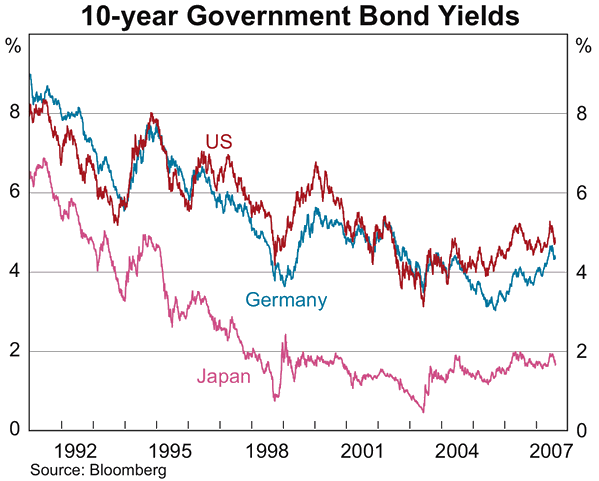
Over 2006/07, the investment of reserves under this framework generated earnings of $2.9 billion, compared with $1.3 billion in 2005/06. This reflects the impact of various factors. Firstly, the size of the Bank's portfolio has increased. Secondly, investments in the United States and Europe, which account for the majority of the Bank's reserves portfolio, benefited from a higher average level of yields than in recent years. This contributed to higher interest earnings, though part of this was offset by losses in the value of existing holdings of bonds as yields rose. In addition, the translation of foreign currency income to Australian dollars at a higher average exchange rate than in previous years lowered the Australian dollar value of foreign earnings.
| US | Europe | Japan | |
|---|---|---|---|
| 2001/02 | 6.1 | 4.7 | 0.4 |
| 2002/03 | 6.6 | 7.2 | 1.3 |
| 2003/04 | 0 | 1.9 | 0 |
| 2004/05 | 4.1 | 5.8 | 1.1 |
| 2005/06 | 1.2 | 0.1 | −0.9 |
| 2006/07 | 5.6 | 2.2 | 1.1 |
| Actual | Benchmark | Value of difference (A$ million) |
|
|---|---|---|---|
| 2001/02 | 3.9 | 3.7 | 63 |
| 2002/03 | 6.7 | 6.4 | 77 |
| 2003/04 | 0.5 | 0.3 | 67 |
| 2004/05 | 4.7 | 4.5 | 38 |
| 2005/06 | 1.2 | 1.0 | 55 |
| 2006/07 | 3.1 | 3.0 | 40 |
The Bank continues to hold a small proportion of its assets in other Asian government bonds, as part of the Asian Bond Fund initiative established by EMEAP central banks to boost the development of bond markets in the region (see the 2005 Annual Report ). These assets are invested in two separate funds, one of which invests in US dollar denominated bonds and the other in local currency denominated bonds. The investment of funds is co-ordinated by the Bank for International Settlements, under a mandate determined by EMEAP. The amount invested by the Reserve Bank in these funds is currently $371 million. The return over 2006/07 was 9.8 per cent across both funds. This is above the returns earned on the Bank's broader reserves portfolio, consistent with the higher average yield available on Asian government bonds, their longer duration and the increase in the market value of bond holdings associated with declining yields.
The Reserve Bank also holds around 80 tonnes of gold, valued at around $2 billion, as part of its official reserve assets. Gold prices rose by around 6 per cent in US dollar terms over 2006/07. However, the rise in the value of the Australian dollar against the US dollar over the year saw the gold price, in Australian dollar terms, fall by 7 per cent.
The Bank is prepared to lend its gold holdings, on a collateralised basis, to major participants in the gold market. Demand for gold loans over the course of the year has continued to be minimal, with interest rates on loans with a maturity up to one year around 4 basis points and around 35 basis points for maturities of up to five years. Given these very low returns, the Bank decided not to renew the bulk of gold loans that matured during 2006/07. As such, the amount of gold on loan fell from 53 tonnes at end 2005/06 to 42 tonnes, and income generated from gold lending activities fell from $13.4 million in 2005/06 to $11.1 million.
The Bank continually reviews the framework under which its investments are made. In the past, major changes to the framework have included an increase in the duration of the US portfolio, from 12 months to 30 months, in 1996 and a reduction in the share allocated to the Japanese portfolio, from 30 per cent to 10 per cent, in 2001. Minor adjustments to the framework are also made from time to time to reflect changes in financial markets, the development of new instruments and changes to the Bank's panel of counterparties. Over the past year, the Bank has added bonds issued by some international financial institutions to its list of eligible outright investments.
As well as these operational changes, the Reserve Bank has a broader responsibility to ensure that its reserves management framework continues to represent the most effective approach to investing reserves. The principles on which the current management framework rest – including eligible markets, instruments and the portfolio's duration – were developed during the first half of the 1990s. At that time, financial markets were smaller and the range of financial instruments narrower than is the case today. With the rapid growth, increased sophistication and increased liquidity of financial markets since that time, a wider range of options is now potentially available for the Bank to meet its investment objectives. Consequently, the Bank is undertaking a broad review of the policies, objectives and guidelines for the investment of foreign reserves. In undertaking this review, the Bank does not envisage any changes to the core policy and operational objectives that underpin the investment of reserves. However, it is possible that the combination of investments which best satisfies these objectives will change.
Risk Management
A range of financial risks arise from the Reserve Bank's balance sheet, including exchange rate, interest rate and credit risk. As these risks derive from the Bank's operations in financial markets, Financial Markets Group has the main responsibility for managing them, within parameters and controls set by the Governor and the Reserve Bank Board. Position and counterparty limits, formal delegations, procedures manuals and market benchmarks are part of the day-to-day control and mitigation of these risks.
Compliance with the control framework for the Reserve Bank's financial market activities is monitored and reported daily by the middle office to both the Assistant Governor (Financial Markets) and Head of the Risk Management Unit. Performance and risk on the Bank's financial assets are also reported daily to senior management. Included in this are exceptions to normal operations, such as system problems, deficiencies in procedures or failures to follow procedures.
Exchange Rate Risk
Exchange rate risk arises from the Reserve Bank's holdings of foreign currency assets, which are used to support intervention operations. The value of these assets (when measured in Australian dollars) varies with movements in the exchange rate between the currencies in which the assets are denominated and the Australian dollar. The size of this risk varies with the size of foreign exchange holdings.
Exchange rate risk is controlled to an extent by diversification of foreign currency assets across three currencies. The exchange rate risk on a portfolio invested across a basket of currencies is lower than the risk on the same size portfolio invested in only one currency. The benefit of diversification, in terms of risk reduction, is illustrated by the fact that over the past five years the Australian dollar has appreciated by 50 per cent against the US dollar, while it has appreciated by only 33 per cent in terms of the basket of currencies held in the Reserve Bank's foreign portfolio, which includes 45 per cent US dollars, 45 per cent euros and 10 per cent yen.
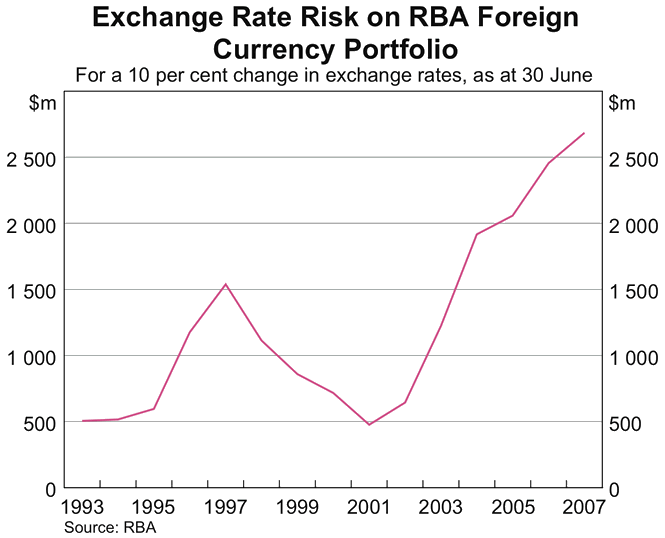
With the Reserve Bank's foreign currency reserves having been returned to normal levels after the interventions around the turn of the decade, foreign currency risk on the balance sheet has increased. As intervention and reserves replenishment operations are determined by policy considerations, the level of exchange rate risk resulting from these operations cannot be offset. Intervention operations themselves do, however, help to reduce exchange rate risk, as they reduce the level of the Bank's holdings of foreign currency when the Australian dollar is low, which reduces the level of risk when the Australian dollar is most likely to appreciate. Conversely, the Bank will tend to hold more foreign currency when the Australian dollar is high and more likely to depreciate. Foreign currency assets acquired through swap operations do not entail foreign exchange risk as the forward rate embedded in the swap hedges the risk.
At current levels of reserves holdings, foreign currency risk is around $2.7 billion for each 10 percentage point movement in the exchange rate. This was the main factor that contributed to the accounting loss reported by the Bank this year (see the chapter on Earnings and Distribution).
Interest Rate Risk
As a significant part of the Reserve Bank's balance sheet is held in securities that earn a fixed rate of interest, the value of the Bank's assets will tend to fluctuate with changes in market interest rates. Increases in market interest rates will reduce the value of these assets, which have a fixed income stream. Conversely, when market interest rates fall investors are willing to pay a premium for the higher fixed income stream offered on existing securities. Securities with a longer maturity (or duration) will have an income stream fixed for a longer period and so will be exposed to a greater degree of interest rate risk.
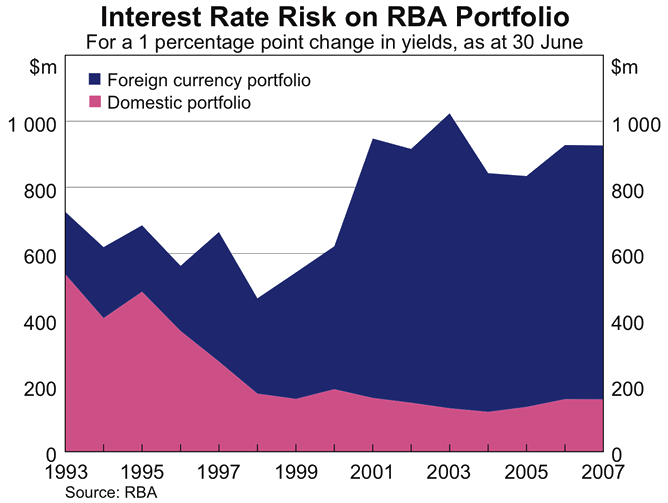
Over the past year, an increase in interest rate risk owing to the growth of the balance sheet has been offset by a reduction in the average maturity of assets. This is because money received for Future Fund deposits was invested in relatively short maturities broadly to match the maturity of the deposits – i.e. the Bank effectively hedged the risk on these deposits. Across the domestic and foreign portfolios, the Bank would suffer a valuation loss of about $950 million if interest rates in Australia and abroad were to rise by 1 percentage point across the yield curve. This has not changed much over the past five years. Such a loss would be partially offset by increases in interest income, over time, as shorter-term investments were reinvested at higher interest rates.
Credit Risk
Credit risk is the potential for financial loss arising from issuer or counterparty default. For the Reserve Bank's operations, this can arise through default by the issuer of securities held outright, default by the banks with which funds have been deposited or default by the counterparties with which transactions have been undertaken. In contrast to exchange rate and interest rate risk, there is no policy imperative for holding a given level of credit risk, so this risk can be reduced to relatively low levels.[3]
To minimise its exposure to credit risk the Reserve Bank mainly holds highly rated securities. In the domestic portfolio, these include securities issued by the Australian Government and State and Territory government borrowing authorities. There are, however, also some repos in bank bills. Securities issued by the US, German, French and Japanese governments, as well as deposits held with the Bank for International Settlements, are the main investments in the foreign portfolio, although some of the portfolio is also held in commercial bank deposits. Over the past year the Bank began to invest a small amount in securities issued by certain highly rated supranational institutions. A small amount of the foreign portfolio is invested in the Asian Bond Funds, which have an average credit rating well within the range of investmentgrade paper.
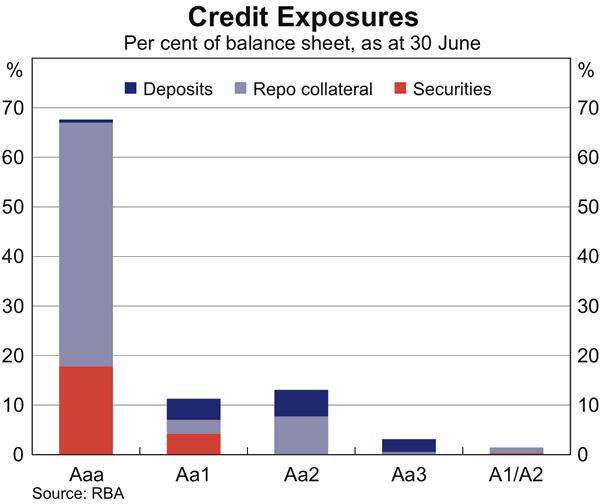
The risk of default by institutions with which the Reserve Bank has deposited funds and by counterparts to transactions with the Bank is controlled in a number of ways. Foreign currency deposits are placed only with commercial banks that have a high credit rating (a shortterm rating of P-1 and a long-term rating of Aa3 or above). Foreign counterparties to transactions with the Bank must also have high credit ratings, with foreign exchange transactions limited to counterparties rated P-1 (short term) and at least A3 (long term), while foreign repos and gold lending transactions, which are secured with high-quality assets, are limited to counterparties rated P-2 and Baa1 or better. Other measures to control risks include requiring repos and gold loans to be over-collateralised, and requiring securities provided as collateral to be revalued daily and that counterparties supply additional securities if the value of the securities falls below a required amount.
To control the size of the loss were a default to occur, exposures to foreign counterparties are limited according to their financial strength, credit rating and the size of their capital base. Credit exposure to each counterparty is aggregated across all the products in which the Reserve Bank has dealt with that counterparty, with individual product exposures standardised through product risk factors.
No minimum credit rating or exposure limits are explicitly assigned in the domestic portfolio as operations are conducted for policy purposes. However, as dealings are restricted to RITS members, which are primarily banks operating in Australia, the credit ratings of domestic counterparties tend to be high.
Settlement risk, which can arise when a counterparty cannot supply the cash or securities to complete a deal, is eliminated for securities transactions through the use of delivery-versuspayment systems, which involve the simultaneous exchange of securities for cash. In contrast, settlement risk can be quite significant for foreign exchange transactions as the two currencies of the foreign exchange transaction are settled in different time zones, which may require the Reserve Bank to pay out funds before it receives any funds in return. While this risk is controlled to an extent by dealing only with highly rated counterparties, the size of any potential loss is further controlled by limiting the total value of foreign currency transactions settling with a given counterparty on a given day.
Footnotes
The exchange rate for the reversal of the swap is determined by adjusting the current exchange rate for the interest rate differential between the two relevant countries for the time to maturity of the swap. Because the exchange rate for the reversal is fixed, foreign exchange held under swaps does not expose the Reserve Bank to risk of valuation losses from adverse exchange rate movements. [1]
Official reserve assets also include Special Drawing Rights and Australia's reserve position at the International Monetary Fund. [2]
Details of the Reserve Bank's credit exposures are given in Note 16 to the Financial Statements. [3]